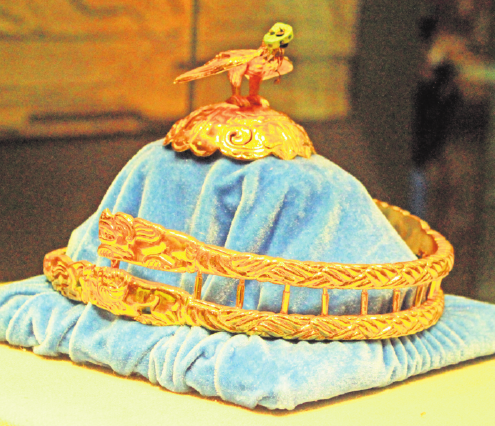
WANG KAIHAO/CHINA DAILY
The 26-meter-high skeleton of Nurosaurus, displayed in the Inner Mongolia Museum, is the biggest dinosaur fossil from the Cretaceous period ever found in Asia.

WANG KAIHAO/CHINA DAILY
The golden crown of a Xiongnu chanyu (nomadic leader),made during the Warring States Period (475-221 BC),is one of the key exhibits in the museum.
With the temperature dipping below freezing, Wang Kaihao finds refuge in the Inner Mongolia Museum in Hohhot, and embarks on a fascinating journey into the region's rich history.
If the Inner Mongolia autonomous region's capital Hoh-hotis the gate way for people from all over the world to explore the region's grasslands and ethnic cultures, the Inner Mongolia Museum in the east of the city is the best guide book for first-time visitors preparing to travel deeper into the region.
During the long winter in Hoh-hot, outdoor tourist attractions lose some of their charm as the whole city is frozen. The museum, however, still offers an excellent travel experience.
Covering an area of 15,000 square meters, the museum has more than 100,000 exhibitions and boasts the country's most complete collection of artifacts of the history and culture of the Mongolian ethnic group. This is my second visit in winter. Compared with visiting in summer, when the place is packed with people, a quiet museum is much more suitable to study the historical legends and take in the panorama of the region's natural wonders.
The museum is free to visit. What makes this trip even better in this low season is that I have a private tour guide for free.
Unusually, the guide starts the tour from the second floor, where the ancient cultures of the vast grasslands are traced back to prehistoric times, giving a brief but informative introduction to numerous nomadic ethnic groups who once lived in this region, including Xiongnu (possible predecessors of Huns),Xianbei and Mongols, as well as their interweaving histories and connections.
A replica of the C-shaped jade dragon, which was first discovered in Inner Mongolia's eastern city of Chifeng in 1971,is an excellent example of the region's rich prehistorical civilizations. The jade dragon, made during the time of Hongshan culture (estimated 4,700 to 2,900 BC) is the oldest dragon image ever found in China.
I am most drawn to the key exhibits of the museum: the only crown of a Xiongnu chanyu (nomadic supreme leader) ever discovered in China. This 1,394-gram golden crown, which was made during the Warring States Period (475-221 BC)and unearthed in Ordos, a city in the west of Inner Mongolia, in 1970,is crested with an eagle overlooking a fight between wolves and sheep.
I try to recall details from my history textbooks about the conflicts and bonds between Xiongnu and southern dynasties over hundreds of years.
I am fortunate to already have some fundamental knowledge of the region after staying in Inner Mongolia for one year.
A hall on the second floor presents the history of other non-Han ethnic groups of Inner Mongolia, especially those living in the far northeast deep in the Greater Hinggan Mountains who still maintain their traditional lifes-tyles, including the Ewenki people who are China's last reindeer raising tribe and practice shamanism. Having once been intoxicated by their mysterious customs, I feel transported there once again as I stare at the pictures and exhibits of daily items and vivid waxworks depicting their lives.
The third floor has several halls focusing on certain themes, including Mongolian paintings, costumes, and Buddhist sculptures, as Tibetan Buddhism became the dominant religion among Mongols in the late 16th century. There is even an interesting section introducing different kinds of saddles. I once had an unpleasant horse-riding experience caused by my poor skills-perhaps, I should have come here earlier to learn more.
The biggest difference between the Inner Mongolia Museum and the National Museum of China in Beijing, is that in Inner Mongolia there are many more displays beyond historic relics and those on traditional culture. This is why the guide tells me to leave the first floor until the end. It is more like a popular science gallery. As a major mining hub, a region with a highly diversified landscape, and home of the country's only spaceport that sends humans into space, Inner Mongolia has many natural at tractions.
Of course, the finale of my afternoon tour is breathtakingly marvelous: In a 3,000-square-meter hall, the larges tin the museum, are gathered various fossils discovered in Inner Mongolia in recent decades. No one can forget the 26-meter-high skeleton of Nurosaurus. Unearthed in 1985 in Chagan Nur, a lake in Inner Mongolia's northern Xilin Gol region, it remains the biggest dinosaur fossil from the Cretaceous period (about 145.5 million years ago to 65.5 million years ago)ever found in Asia.
After walking for so long and absorbing so much knowledge, it's advisable to rest both mind and body.
IF YOU GO
The fastest train ride between Beijing and Hohhot takes 6.5 hours. A flight between the two cities takes 50 min-utes. The museum is linked to many bus lines.
9am-5pm, no entrance after 4pm. The museum is closed on Mondays. Group reservation 0471-461-4000; Information Desk 0471-461-4333. Websitewww.nmgbwy.com (in Chinese).

CHINA DAILY
Contact the writer at wangkaihao@chinadaily.com.cn.
We recommend:
